Star spotted on Florida coasts!
Heads up, fans of Florida’s celebrity nonnative herps! There’s a niche member of the scaly glitterati you may have missed in all the furor over Florida’s top-billing nonnative reptiles.
Trendsetters you already know
Naturally shutters click, flashbulbs pop, and bulletins arrive almost weekly about the exploits of the various enormous invasive constrictor snakes relentlessly digesting everything that walks, swims, or flies in the Everglades.
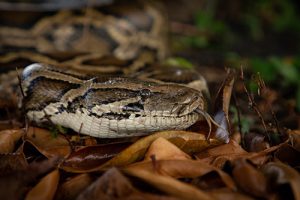
Every winter, nonnative reptile news junkies are treated to a sheaf of stories about frozen invasive iguanas falling from manicured landscape trees in Fort Lauderdale onto unsuspecting pedestrians below. Add to that their highly newsworthy tendency to burrow through sea walls and munch on landscaping, and it’s hard to wrest the spotlight away from these literal scenery chewers.
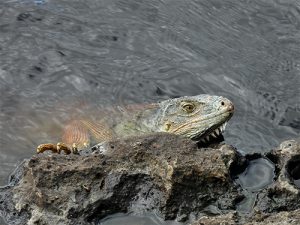
And gossip flows steadily about the rapacious invasive tegus pillaging alligator nests in the southern part of the state.
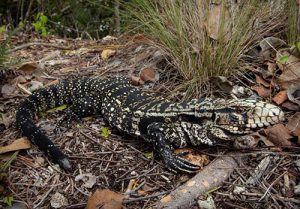
Of course, nobody can even go outside practically anywhere in the state of Florida without seeing a nonnative brown anole. Or sixteen. Or sixty. They’re all around us all of the time, racing down sidewalks, leaping from shrubbery, clinging tenaciously to our cars like living hood ornaments, forever hurtling forth in fierce pursuit of fame*.

Who is it?
Our mystery nonnative reptile celebrity, by contrast, has received little fanfare, and in fact you might not even know it’s in the state, at all. If you’ve watched nature documentaries, though, or even the odd TikTok, you’ve probably learned about and marveled at this remarkable little animal.
Can’t guess?
It’s the brown basilisk, the little critter with the big talent, the lizard that walks on water! Its famous semi-aquatic trick makes for great footage, so this shy brown lizard gets a lot of screen time. It has developed a big reputation and a devoted fan following.
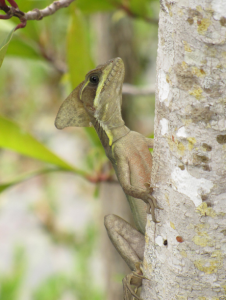
Brown basilisks in Florida
A new Ask IFAS publication explains that it was those same devoted fans who brought the brown basilisk lizards to Florida habitats in the first place. Like many other nonnative reptiles now living in the wild in Florida, brown basilisks were originally introduced as pet animals and are now established here. They were first spotted at large in Florida in 1963.
The lizards have yellow or cream-colored stripes on their sides, and both male and female lizards sport little crests on their heads when they’re grown. They usually lose much of their ability to run on water as they get heavier, so most of the footage you see of their famous trick features juvenile lizards without the distinctive crests. The grown lizards are still comfortable in and around water, and, though they may not do much waterwalking anymore, are still plenty athletic. Adult lizards can still do their spectacular hind-leg running on solid ground. They’re good swimmers, too, and can dive beneath the surface of the water if they’re threatened.

Refreshingly gracious and polite for a celebrity nonnative reptile
Wherever they end up, basilisks appear to favor the coasts. They are originally from coastal regions of Central America, ranging from central Mexico south to Panama. In Florida, they hug the Atlantic and Gulf Coasts, and the southern coast of Lake Okeechobee. They usually prefer to be left alone, and you probably won’t see them because, in the time-honored tradition of reclusive celebrities, they hide and avoid attention. If you do get to see one do its nifty trick, count yourself lucky!
Unlike so many of their more notoriously badly behaved and destructive fellow nonnative reptiles, about which you can learn here, brown basilisks have not made a tremendous impact outside their native range and do not appear to be doing much harm in their new home. Brown basilisks haven’t been studied as much as other nonnative species, though, so there may be undiscovered problems we’re not yet aware of.
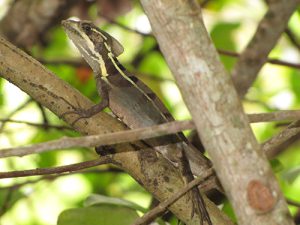
Hoping to stay up to date on all the hot new Florida wildlife gossip? Need to stay relevant in an always changing ecology? Or just want to learn more and find out how you can help manage Florida’s nonnative species? Explore Ask IFAS.
Source: UF/IFAS Pest Alert



